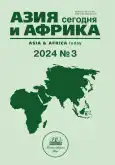“Bride Exports” in Media Discourse of Vietnam and China
- Autores: Grigoryeva N.V.1, Starikova S.A.1
-
Afiliações:
- HSE University
- Edição: Nº 3 (2024)
- Páginas: 74-82
- Seção: Politics, economics
- URL: https://journals.rcsi.science/0321-5075/article/view/257215
- DOI: https://doi.org/10.31857/S032150750029389-9
- ID: 257215
Citar
Texto integral
Resumo
Palavras-chave
Sobre autores
Nina Grigoryeva
HSE University
Email: ngrigoreva@hse.ru
ORCID ID: 0000-0003-3948-720X
PhD (History), Associate Professor, Head, Department for Chinese, South and Southeast Asian Studies Saint Petersburg
Sabina Starikova
HSE University
Email: sastarikova@edu.hse.ru
ORCID ID: 0009-0006-5244-4131
5th year student, Program “Asian and African Studies” Saint Petersburg
Bibliografia
- Phuong Vu. 2018. Workshop reviews assistance for returnee victims of trafficking. VNA. https://en.vietnamplus.vn/ workshop-reviews-assistance-for-returnee-victims-of%20trafficking/138095.vnp (accessed 15.03.2023)
- Maochun L. & Wen C. 2014. Transnational Undocumented Marriages in the Sino-Vietnamese Border Areas of China.
- Asian and Pacific Migration Journal. 23(1), pp. 113–125. doi: 10.1177/011719681402300105
- Vu Thi Thanh. 2021. Vietnamese migrant women working abroad: risks and challenges for accessing support services.
- DEMIS. Demographic research. Vol. 1. № 1. Pp. 71–78. doi: 10.19181/demis.2021.1.1.8
- Davin D. 2007. Marriage Migration in China and East Asia. Journal of Contemporary China. Pp. 83–95. doi: 10.1080/10670560601026827
- Su Lianling. 2013. Cross-border marriage migration of Vietnamese women to China. A thesis submitted in partial fulfillment of the requirements for the degree Master of Arts. Kansas State University. https://krex.k-state.edu/handle/ 2097/15663?show=full (accessed 15.12.2023)
- Stöckl H., Kiss L., Koehler J. et al. 2017. Trafficking of Vietnamese women and girls for marriage in China. Global Health Research and Policy. 2, 28. doi: 10.1186/s41256-017-0049-4
- Le Phuong Thao. 2014. Trafficking experiences and psychological dysfunction among female trafficking survivors returning to Vietnam. The Lancet. Vol. 2, Special issue, S46. doi: 10.1016/S2214-109X(15)70068-9
- Grillot C. 2012. Between Bitterness and Sweetness, When Bodies Say it All: Chinese Perspectives on Vietnamese Women in a Border Space. Journal of Vietnamese Studies. Vol. 7(1). Pp. 106–148. doi: 10.1525/vs.2012.7.1.106
- Barabantseva E., Grillot C. 2019. Representations and Regulations of Marriage Migration from Russia and Vietnam in the People’s Republic of China. Journal of Asian Studies. Vol. 78(2). Pp. 285–308. doi: 10.1017/S0021911819 00010X
- Bélanger D., Khuất Thu Hồng, Trần Giang Linh. 2013. Transnational Marriages between Vietnamese Women and Asian Men in Vietnamese Online Media. Journal of Vietnamese Studies. Vol. 8(2). Pp. 81–114. DOI: 10.1525/ vs.2012.7.1.106
Arquivos suplementares










